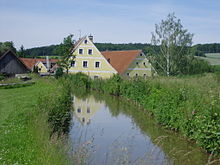Hasenmühle (Heidenheim)
|
Rabbit mill
Heidenheim market
Coordinates: 48 ° 58 ′ 20 ″ N , 10 ° 43 ′ 34 ″ E
|
|
|---|---|
| Height : | 472 m above sea level NN |
| Residents : | 3 (Jun 30, 2011) |
| Postal code : | 91719 |
| Area code : | 09833 |
The rabbit mill is a wasteland and a district of the market Heidenheim in the central Franconian district of Weißenburg-Gunzenhausen ( Bavaria ).
location
The Hasenmühle is located in the Franconian Alb in the Rohrach valley south of the Heidenheim district of Hechlingen at the northern end of the Hahnenkammsee and on the state roads 2384 and 2216.
Surname
The mill is not named after the animal name "Hase", but rather after the common person or field name "Haso" or "Has (e)".
history
The "Hasenmül" is mentioned first documented in 1393, when she from Kloster Heidenheim under Abbot Ulrich Konrad and Adelheid Mülner to Enhofen on inheritance based on fief is given. She had not only in kind and money donations to the monastery as the landlord and after its secularization (1537) to the Brandenburg-ansbachische to make steward Heidenheim, but also to the nürnbergisch-burg Count , later Brandenburg-ansbachische Office Hohentrüdingen that the bailiwick on exercised the mill. The spelling of the mill name changes in the documents, which were mostly issued when the owner changed: Hasen Mül (1400), Haß Mull (1518), Haaßmühl (1608), Haßen Mühl (1658), Haßmühl (1682), Haas Mühl (1732), Hasenmühl (1739).
The Salbuch monastery in Heidenheim from 1400 lists taxes on grain, oats, cheese, eggs, an autumn chicken and a carnival chicken for the rabbit mill; a fee was also payable. In the Burggrafenurbar from 1435 a Hanns Mulner sits on the "Hasenmüle"; he too has to pay in kind and money to the burgrave office. In the Margravial-Hohentrüdinger Salbuch from 1535 it is reported that the "Haßmüll" is a "Seg- und Mallmüll" and has to pay contributions in kind and money. Around 1650, shortly after the end of the Thirty Years' War , a list of the Hohentrüdingen caste office reports that the mill of the rabbit miller Georg Wenderlein is still standing. In 1670 it pays half to the monastery administrator's office in Heidenheim and half to the caste office in Hohentrüdingen. In 1740, when the sawmill was renewed, there was a dispute between Ansbach and Oettingen because of the free wood supply. At the end of the Holy Roman Empire , in 1799 the "Haasmühl" was subordinate to the Ansbach-Prussian caste office Hohentrüdingen "with a subject belonging to it". Ecclesiastically it is assigned to the Protestant parish of Hechlingen.
In 1791/92 the mill with the margraviate of Ansbach became royal- Prussian and in 1806 royal-Bavarian. When tax districts were formed in 1808 , the Hasenmühle with Steinhart and the Stahlmühle formed the Hechlingen tax district in the Heidenheim district court . 1810 of the tax district, including the Balsen- and was check mill for Rural community transformed. By the community edict of 1818, the community of Hechlingen was restored in its old form, i.e. only with the rabbit and steel mill.
1833 was Mühlgerechtsame the Hasenmühle of a grinding and a Gerbgang as oil and Lohmühlenstraße as well as a cutting mill. In 1862 the district court of Heidenheim, in which Hechlingen and thus the Hasenmühle had been located since 1808, became part of the district office (later the district) of Gunzenhausen.
In 1947 a turbine and a new roller mill were installed; In 1984 milling ceased; Since then, the grinder has only been used occasionally for grinding , as has the sawmill. A generator has been producing electricity since 1989 . In 1961 13 people lived in the mill's residential building; The school location for the children from the mill was Hechlingen. With the regional reform in Bavaria , the municipality of Hechlingen came to Markt Heidenheim on May 1, 1978. Today, on the "Mühlfeld", first mentioned in 1533, the mill owner operates the camping site "Hasenmühle" with around 50 parking spaces.
literature
- Johann Caspar Bundschuh : Geographical Statistical-Topographical Lexicon of Franconia , 2nd volume, Ulm 1799, column 452.
- Hanns Hubert Hofmann: Historical Atlas of Bavaria, Franconia Series I, Issue 8: Gunzenhausen-Weissenburg , Munich 1960.
- Robert Schuh: Gunzenhausen. Former district of Gunzenhausen . Series of Historical Place Name Book of Bavaria. Middle Franconia, Volume 5: Gunzenhausen . Munich: Commission for bayer. State history 1979.
- Fridrich Lutz: Hechlingen am See 899-1999. 1100 years of local history; Heidenheim: Marktgemeinde 1999.
- 1250 years Heidenheim am Hahnenkamm. Heidenheim: Historischer Verein 2002, p. 98.
Individual evidence
- ↑ Schuh, p. 123
- ↑ 1250 years Heidenheim, p. 98
- ↑ All information from: Schuh, p. 122f.
- ↑ Lutz, pp. 515, 521, 531
- ↑ Lutz, pp. 520, 532
- ↑ a b Lutz, p. 294
- ↑ Bundschuh, Volume 2, Col. 452
- ↑ Historical Atlas, p. 127
- ↑ Historical Atlas, p. 234
- ↑ Historical Atlas, p. 223
- ↑ Lutz, p. 294f.
- ↑ Bavarian State Statistical Office (ed.): Official city directory for Bavaria, territorial status on October 1, 1964 with statistical information from the 1961 census . Issue 260 of the articles on Bavaria's statistics. Munich 1964, DNB 453660959 , Section II, Sp. 785 ( digitized version ).
- ^ Federal Statistical Office (ed.): Historical municipality directory for the Federal Republic of Germany. Name, border and key number changes in municipalities, counties and administrative districts from May 27, 1970 to December 31, 1982 . W. Kohlhammer, Stuttgart / Mainz 1983, ISBN 3-17-003263-1 , p. 731 .
- ↑ Lutz, pp. 295, 348


